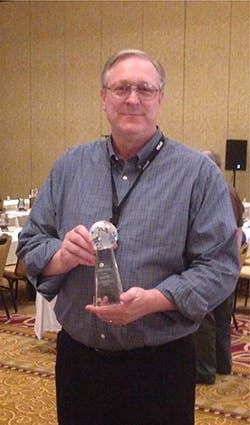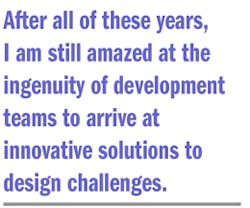This file type includes high-resolution graphics and schematics when applicable.
Bill Devenish is the principal engineer-global DFx at the Kohler Company. At the Boothroyd Dewhurst 2016 International Forum on Design for Manufacture and Assembly (DFMA) in Providence, R.I., June 7-8, Devenish accepted the DFMA Supporter of the Year Award. The Forum is considered the foremost conference worldwide on DFMA methodologies and software. This year’s theme was “DFMA Design Decision: Understanding Total Product Cost.”
What is your background and what brought you to this show?
I was first introduced to design for manufacture and assembly when I began my career as a mechanical engineer in the latter part of the 80s. My focus at the time was on using DFMA principles to simplify product design. However, it wasn’t until 2005 that I began utilizing the full capabilities of the DFMA software tools provided by Boothroyd Dewhurst.
I had been asked to lead a cost-reduction effort on a newly launched product that proved to be more successful than management had originally thought. After a thorough vetting process, the decision was made to implement the DFMA tool into our development process, and I was given responsibility for institutionalizing it. This included organizing off-site training workshops for cross-functional teams from engineering, manufacturing and sourcing. DFMA enthusiasts were selected from the cross-functional teams to become the experts in using the tool and methodology to support new product design efforts. Throughout this process, we received tremendous support from the people at Boothroyd Dewhurst which led to a long-lasting working relationship between us.
Since then, I have implemented DFMA into the culture of other small and large companies. Currently, I am with Kohler Company, and was attracted to join them last year because of their commitment to employing DFMA throughout their organization. It is one of the few companies supporting the adoption of DFMA from both the executive and user levels. Management is providing the resources and the users are eager to provide their expertise. My role is to help the organization improve their awareness and competency of the tool and methodology.
My enthusiasm for DFMA has led to my attendance at most of the annual DFMA Forums since 2005. During that time, I have been involved in writing and presenting seven papers about DFMA adoption efforts and successes. At this year’s Forum, I decided to take a different approach and share a few lighthearted and interesting observations about engineers and their various approaches to problem solving, sprinkled with a few DFMA achievements at Kohler. Attending the Forum throughout the years has provided a wide range of opportunities to learn from other DFMA users and share my experience.
What are some of the innovative ways you have achieved milestones in cost reduction?
After all of these years, I am still amazed at the ingenuity of development teams to arrive at innovative solutions to design challenges. Sometimes there are huge, one-time breakthroughs, but usually it’s a combination of small things that add to significant saving opportunities.
A few years ago, I worked with a team that was designing a next-generation tablet device. We started by baselining the design of their existing product using the DFMA tool. By the time the analysis was completed, the team had identified a long list of improvements to simplify the design.
One of the ideas was to replace one of two screws securing a connector with an integrated pin in the metal frame. As the idea was discussed, one of the engineers grabbed a prototype printed-circuit-board assembly with the connector, attached it to the frame with the two screws, broke the head off one of the screws to represent the function of a pin, and demonstrated that the idea was feasible. This one idea resulted in $1M annual savings through reduced part count and assembly time. The process of analyzing their design using the DFMA methodology led to this and many more ideas for cost reduction on their new design, which resulted in a total of $17M savings over the life of the product.
You talked about engineers avoiding the unintended consequences of design decisions. What are these consequences and how do we avoid them?
Oftentimes, a variety of forces conspire to move engineers from design concept, usually only a proof of concept, to the next phase in their development process. This pressure to start moving toward the scheduled end date masks many challenges that pop up at inconvenient times as the project team attempts to move closer to product release and production.
Early design analysis uncovers risks that can be mitigated through either redesign or prototype testing. When more time is spent in the early stages, there are fewer problems later and a higher probability of meeting the scheduled release date. It seems counterintuitive, but it is better to slow down so we can speed up.
Are there ways to improve feedback or communication on a product after it has gone to market, so that designers understand there was a design flaw?
I’ll meet you half-way on this one. When I was the Director of Engineering at a small electronic hardware company, I required the design engineers to build the pilot run of 100 units while the assembly technicians observed. This had never been done there before.
Even though the manufacturing personnel had been active participants during the design process—another first—the engineers gained valuable firsthand experience about the difficulties of their design when they had to build all 100 instead of just one or two prototypes. They were able to immediately implement a few design changes to improve the assembly, but the significant improvements showed up on the next product design as they recalled their first experience on the assembly line.
An excellent feedback loop for design engineers is to build their own designs. Even though a physical wall still separated the engineers from manufacturing, this experience eliminated the cultural wall that had gradually been built.
At the DFMA Forum, you talked about understanding engineers. What is important about understanding engineers?
The key to understanding engineers is observing their approach to problem solving.
Prior to the introduction of the Dilbert comic strip by Scott Adams, there was a cartoonist by the name of Rube Goldberg who graphically characterized the approach that some engineers take to problem solving. While Dilbert highlights the absurdity of office politics within engineering companies, Rube Goldberg illustrated the tendency of engineers to turn a simple solution into a highly complex series of interdependencies. Sometimes engineers can over complicate the simplest of solutions.
At the other extreme, engineers often follow the product simplification goal of DFMA by approaching problem solving through the application of basic engineering fundamentals. To achieve these simple solutions, engineers have developed the ability to view problems with emotional detachment. They break problems down to their simplest form, placing the pieces into neat little compartmentalized categories. Engineers then view the cold, hard facts and weigh the variables to reach a streamlined conclusion.
Engineers also have a unique sense for observing technical details that are missed by others. Their focus remains unwavering while chaos swirls around them. In the end, they state the obvious, which had previously been unknown to others.
Creativity and inventiveness are sometimes synonymous with the description of engineers. They are occasionally motivated by self-interest, although most of the time their motivation comes from the desire to continuously improve and achieve technical perfection. This drive to perfection is sometimes at the risk of their own safety and comfort.
Engineers are inspired through unconventional means. For instance, a group of engineers in the 60s recognized that a patent submitted by the famous actress Hedy Lamarr in the early 40s would lead to secure wireless communication using a technique she had invented known as frequency hopping. As a result, we now have the proliferation of cell phones, Wi-Fi, and Bluetooth.
Recently, it has been observed that millennial engineers tend to have short attention spans. This may be a result of their maturation during an age when learning, and the accumulation of knowledge, was gained through video interactions. Therefore, reaching and motivating this new generation of engineers requires that information be condensed and distributed in small, short, audio-visual bursts.
Finally, if you want to drive engineers crazy, give them conflicting requirements and watch a type of office road rage occur. Then sit back and observe how they solve the problem.
Looking for parts? Go to SourceESB.
This file type includes high-resolution graphics and schematics when applicable.



